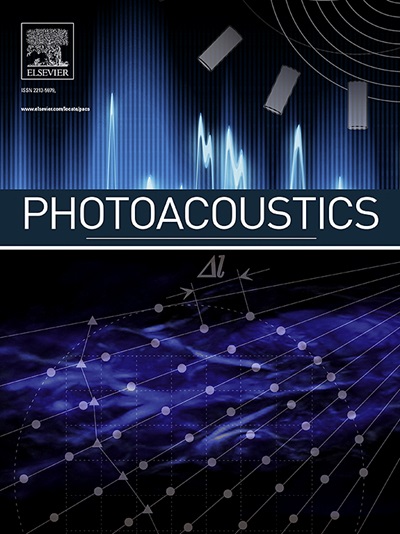Artificial intelligence-assisted laser ultrasound method for the estimation of porosity in hairpin weld seams
IF 6.8
1区 医学
Q1 ENGINEERING, BIOMEDICAL
引用次数: 0
Abstract
Hairpin technology is being used as a replacement for the traditional winding stator in electric motors. In hairpin stator manufacturing, copper rods are used to achieve a higher slot fill factor. These rods are joined together in pairs through laser welding, forming a closed circuit. However, this welding process is prone to air inclusions in the welds, which can negatively impact the efficiency and durability of the motor. The present study aims to estimate the total volume of these air inclusions using laser ultrasonic measurements. Laser ultrasound is a fast, non-contact, non-destructive method that can cope with the limited sample accessibility, making it ideal for inline testing of these weld seams. To evaluate the effectiveness of laser ultrasound, a stator was intentionally manipulated prior to laser welding to favor the formation of air inclusions. The porosity of the weld seams was determined through computed tomography images. It was demonstrated that due to the complex geometry of the hairpin welds, leading to a complex ultrasound wave field, standard methods to estimate the porosity from laser ultrasound B-scans are difficult to apply. As an alternative approach, an algorithm that is based on artificial intelligence was utilized for the purpose of estimating the air inclusion volume in the welds from laser ultrasonic measurements. The outcomes demonstrated a median correlation of 0.6 between this estimate and the pore volume obtained from the computed tomography data, despite the utilization of only 48 samples. Moreover, these results were evaluated against a model where the labels were randomly mixed, and highly informative regions regarding pore volume were identified in the B-scans, which have the potential to accelerate the process of acquiring data.
人工智能辅助激光超声评估发夹焊缝孔隙率的方法
发夹技术正被用作电动机中传统绕组定子的替代品。在发夹定子制造中,铜棒用于实现更高的槽填充系数。这些棒通过激光焊接成对地连接在一起,形成一个闭合回路。然而,这种焊接过程容易在焊缝中产生空气夹杂物,这会对电机的效率和耐用性产生负面影响。本研究旨在利用激光超声测量来估计这些空气夹杂物的总体积。激光超声是一种快速、非接触、非破坏性的方法,可以处理有限的样品可及性,使其成为这些焊缝在线测试的理想选择。为了评估激光超声的有效性,在激光焊接之前有意地操纵定子以有利于空气夹杂物的形成。通过计算机断层扫描图像确定焊缝的孔隙率。结果表明,由于发夹焊缝的复杂几何形状,导致了复杂的超声波场,难以应用激光超声b扫描估计孔隙率的标准方法。作为一种替代方法,一种基于人工智能的算法被用于从激光超声测量中估计焊缝中的空气夹杂物体积。结果表明,尽管仅使用了48个样本,但该估计值与计算机断层扫描数据获得的孔隙体积之间的中位数相关性为0.6。此外,这些结果是根据标签随机混合的模型进行评估的,并且在b扫描中确定了有关孔隙体积的高度信息区域,这有可能加速获取数据的过程。
本文章由计算机程序翻译,如有差异,请以英文原文为准。
求助全文
约1分钟内获得全文
求助全文
来源期刊

Photoacoustics
Physics and Astronomy-Atomic and Molecular Physics, and Optics
CiteScore
11.40
自引率
16.50%
发文量
96
审稿时长
53 days
期刊介绍:
The open access Photoacoustics journal (PACS) aims to publish original research and review contributions in the field of photoacoustics-optoacoustics-thermoacoustics. This field utilizes acoustical and ultrasonic phenomena excited by electromagnetic radiation for the detection, visualization, and characterization of various materials and biological tissues, including living organisms.
Recent advancements in laser technologies, ultrasound detection approaches, inverse theory, and fast reconstruction algorithms have greatly supported the rapid progress in this field. The unique contrast provided by molecular absorption in photoacoustic-optoacoustic-thermoacoustic methods has allowed for addressing unmet biological and medical needs such as pre-clinical research, clinical imaging of vasculature, tissue and disease physiology, drug efficacy, surgery guidance, and therapy monitoring.
Applications of this field encompass a wide range of medical imaging and sensing applications, including cancer, vascular diseases, brain neurophysiology, ophthalmology, and diabetes. Moreover, photoacoustics-optoacoustics-thermoacoustics is a multidisciplinary field, with contributions from chemistry and nanotechnology, where novel materials such as biodegradable nanoparticles, organic dyes, targeted agents, theranostic probes, and genetically expressed markers are being actively developed.
These advanced materials have significantly improved the signal-to-noise ratio and tissue contrast in photoacoustic methods.
 求助内容:
求助内容: 应助结果提醒方式:
应助结果提醒方式:


